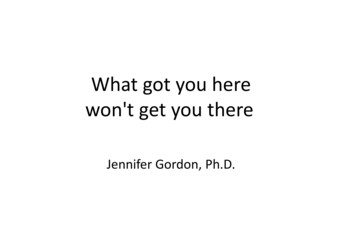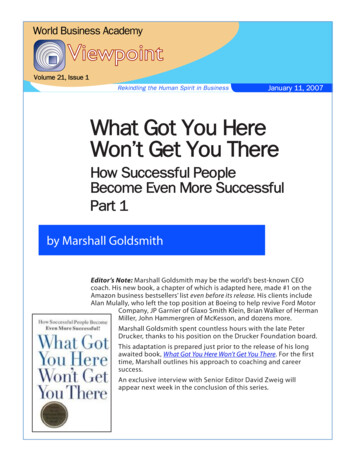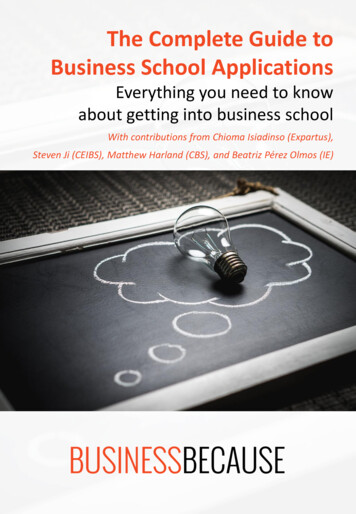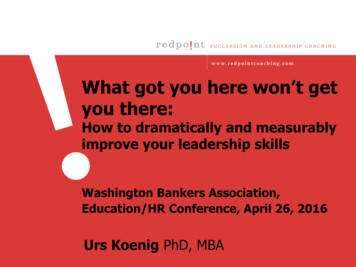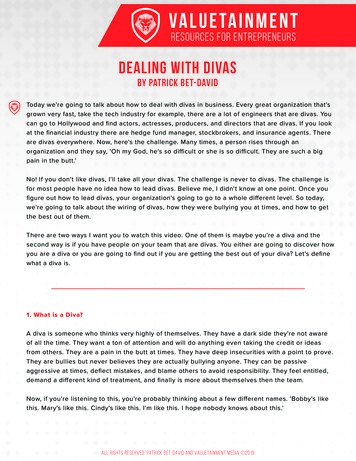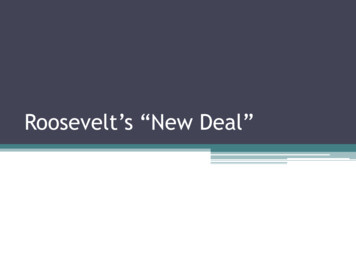
Transcription
What got you herewon’t get you thereEvolving themerchandising functionin today’s battlefor share
Contents3Introduction5The business imperatives: Why change course?7The transformative strategies:What are the elements of the new operating model?10How do I make it happen?12ConclusionWhat got you here won’t get you there Retail POV2
What got you here won’t get you thereEvolving the merchandising function intoday’s battle for shareThe technologies that are changing the retailworld are there for everyone to see. There’sno escaping the tactical transformations:Consumers increasingly use digital means toresearch, shop, and transact, while retailersuse the same advances to connect, assort,and deliver. But is there more going on thanjust the march of technological progress?Deloitte spent six months interviewing a broadcollection of retail executives, industry analystsand leading industry thinkers. These peopleform a substantial cross-section of the industryand serve as a barometer on where theindustry is heading. It was our goal tounderstand their views on the changingbusiness landscape—and the implicationsthose views will have on the operating modeland the organization—in the hope of forminga collective view that goes deeper than theheadlines.Technology has rewritten whatconsumers demand, what retailersare capable of, and how retailerscompete with one another.Assortment as a concept is nolonger tightly bound to physicalinventory. A customer relationshipcan be just as strong over athousand miles as it used to be overa few city blocks.While the opinions of those we interviewedcertainly vary, with some retail executivesthinking we are in the midst of a totaldisruption never before seen, others havemore moderate interpretations. But taken as awhole, their inputs paint a clear picture of asubstantial shift. Their candid observationsform the basis of this paper. More than 1,200discrete inputs later, here’s what we learned:As used in this document, “Deloitte” means Deloitte Consulting LLP a subsidiary of DeloitteLLP. Please see www.deloitte.com/us/about for a detailed description of the legal structure ofDeloitte LLP and its subsidiaries. Certain services may not be available to attest clients underthe rules and regulations of public accounting.3
If you’re a merchant, you’re always hearing about the“next big thing”. But the transformation of the retail worldthat’s happening right now is about far more than ekingout another 2 percent.isn’t a market evolution – it’s a technology-drivendisruption. One retailer told us, “If you think the answer isomnichannel, you’re already too late.” This change goesbeyond channels altogether.Technology has rewritten what consumers demand, whatretailers are capable of, and how retailers compete withone another. Assortment as a concept is no longer tightlybound to physical inventory. A customer relationship canbe just as strong over a thousand miles as it used to beover a few city blocks.This is a transformation retailers need to adapt to on manyfronts: capitalization, value-chain construct, infrastructure,marketing, talent, and finance, to name a few. As oneretailer said, “I can see a future where marketing andmerchandising must work much closer together alignedaround customer groupings, then hand over to a biggersupply chain team – a pretty dramatic organizationalchange.” As we heard in one interview, “It’s all aboutcompetition – ‘if I don’t have to change, I won’t.’However, that position is no longer viable.”“Traditionally, we used last year’s salesdata to drive the assortmentdecisions. We didn’t use consumerinformation or insights.”- Industry ExecutiveAnd a business model that didn’t exist a dozen years ago– the no-footprint, no-inventory, just-add-water retailerwith an instant global reach and limitless assortmentoptions – is here to threaten the traditional model.Technology has unleashed an onslaught of newcompetition with a different business model at the core.One industry executive referred to this onslaught as “adeath by a thousand paper cuts.”Traditionally, scale has been the large retailer’s bulwarkagainst change, and acquisition was the lever that made itpossible for large institutions to move in a way thatmimicked the agility of smaller competitors.But again technology is playing a role in reducing thebarriers to entry, meaning size can no longer protect youas it once did. Just ask the many familiar brands thataren’t here anymore. And the changes that are underwaytoday are not like the ones those companies faced. ThisWhat got you here won’t get you thereTo be nimble without identity is to attempt to be all thingsto all people – which is to say, to stand for nothing.“Whatever you want, I can have it on your doorsteptomorrow” is a seductive path to follow because of howeasy technology makes it simply to throw more SKUs intothe virtual mix. But it’s already well on its way tobecoming a commoditized promise with price, ease, andspeed as the ‘race to the bottom’ competitive dimensions.On the other extreme, the meaning and good will thatreside in your venerable brand aren’t enough to see youthrough without a fresh approach to your fundamentalvalue proposition – with merchandising and assortment inthe crosshairs.If your brand stands for something – and you carry outthat promise in the new ways that digitally connectedconsumers demand – you can emerge from this disruptionwith a strong future. As one retail pro advised,“Understand what products really represent the brand.”Securing that outcome means breaking down thechallenge, the response strategy, and the right early movesinto distinct questions.4
The business imperatives:Why change course?1. Reduced barriers to entry:Bringing in more small, nimble players changes thenature of competition. The old, capital-intensiverequirement to own all or most of the value chain is nomore. Today, competitors can launch a competitiveretail brand in a matter of hours with little more than acredit card in hand. And the retail value chain has beenirreversibly affected.By now, the technology advancements are familiar:complete consumer transparency on price, features,options, and availability. Virtual shopping that, in certaincategories, begins to takes geography out of thecompetitive equation. The definition of a new profit modelthat decouples inventory and assortment and seeks newpaths to revenue. And fulfillment at a pace that mightonce have counted as science fiction.While many people think of these changes from theconsumer’s point of view, they have been just astransformative for retailers themselves. In particular, theyhave unleashed an onslaught of competitive pressure.Casting this as an online vs. bricks and mortar battledoesn’t go far enough, because the lines between digitaland physical are rapidly blurring and will be even moremuddled as technology progresses. In a no- to limitedgrowth environment with an onslaught of newcompetitors, the real battle is for market share.“We think we know our customer, butit has become clear that we don’t. It isclear to me that we are a productcentric organization living in anincreasingly customer-centric world.”- A retailerA new competitor can literally outsource any or all ofthe value chain, from acquiring assortment to sell andinventory ownership through customer call-centersupport, to email marketing, store hosting, anddelivery, through to payment processing. Even theassociate-as-employee model is being challenged withnew models leveraging networks of people ready tosell, deliver or support. This dramatically changes thecapital requirement necessary to play.One interviewee summed it up: “If small retailers nolonger need the same level of capital to play, large onesno longer need physical at-scale presence to reachmillions of customers.” The net effect is a flood ofcompetitors operating on surprisingly equal terms. In amarket with stagnant growth, this intensifies thecompetition for market share and intensifiescompetitive behavior.2. Decoupling of assortment from inventory:The Pareto curve of retail is flattened because forwarddeployed inventory no longer drives sales the wayit once did, supply and demand are increasinglyseparate, and demand that extends beyondgeographic proximity unlocks long-tail opportunities.Thanks to the rise of this distribution model, retailerscan have an assortment without the correspondingpresent physical inventory. This corresponds to thenew assortment of expectations of consumers whohave become more accustomed to purchasing andhaving products shipped to them. Because of advancesin drop-ship capabilities, retailers can not only sell5
items they don’t have on hand at stores – they caneven sell items they don’t own in physical inventory.This unleashes the potential to think differently aboutwhat a retailer sells and how.“Before, we simply would have hadmissed sales and never have known it.Now that we have better visibility todemand, we at least know how badwe are at inventory management.”- A retailerorganization,” one interview subject said, elaboratingthat there are three likely paths forward: a completelysiloed approach, an approach based solely on storeexperience with no web team, or a middle ground inwhich a web-dedicated planner works with buyers forweb-only items.Very few retailers have figured out how to bringthis sales model into the store where more than 90percent of retail still happens today. “The big unlockwill be when traditional retailers crack the code fortheir entire business.”3. Reduced cost to buy:That means demand aggregation is now a functionof technology, not just geography. That affectseconomies of scale and adds viability to offeringsthat were once too “niche” to survive. It’s left to theretailer to pull the consumer to shop with it instead ofgoing somewhere else. As described by one executive,“This is a fundamental shift in the model.”“The retailer used to define what customers wanted,especially in fashion,” one retailer said. “That iscompletely reversed now – this is subtle in a way, butcompletely revolutionary. The old way was supplydriven; now we are demand driven.”Before they can apply that lesson, traditionalretailers need to move away from the traditionalrelationship between assortment and inventory, andleave its limitations behind. Some retailers may say“We are already doing this,” but the truth is for thevast majority of retailers that may be exploring thisconcept, they are largely only doing it in their on-linebusiness unit, which still represents a small portion ofthe business.“I imagine a world of just-in-time inventory,customization, and, perhaps 20 years out, 3Dprinting in certain categories, in a near-term singleWhat got you here won’t get you thereThe traditional assumptions about what the consumershould invest in the buying process have been broken.Retail price is only one component of what it costsa consumer to research and acquire an item. Othersinclude research time, travel time, gas, parking, effort,and frustration. Those costs add to the burden ontraditional retailers – because they may “match theprice” of an online retailer only to find they haven’tcome close to matching the consumer’s cost tobuy. The cost to the consumer of options has beendramatically decreased by technology, and the netresult has been increased fragmentation of spend asconsumer options come at a dramatically reducedoverall cost.Many in the market argue that “the consumer haschanged.” But our interviews tell us that the consumeris still rational, and still evaluates the market for whatthey consider to be the most valuable offering. Whathas really changed is that competition has increased,and new entrants are offering the consumer manymore options of increasing and differentiated value.The consumer is simply reacting to a new set ofoptions.In this environment, “consumer-centric” can’tbe a motto or a gloss on old practices. It hasto be a completely new way of operating.
The transformative strategies: What arethe elements of the new operatingmodel?services, content, and offerings.” A retailer truly is able toset assortment and decide: “What should we sell? Whatdoes she want from us?” without limitations. Thisprinciple alone establishes a vastly different approach.Deloitte’s research shows that digitaltechnologies influence 49 percent ofin-store retail sales, a number likely toincrease to 64 percent by end of 2015.The voice of the customer is not quiet.If retailers continue to operate with the traditionalconstraints that accompany a physical inventory mindset,they risk missing the opportunity of the new digitalmarketplace and leaving themselves at a fundamentaldisadvantage to the retailers who have broken thoseconstraints – or never knew them to begin with.Putting together a new retail merchandising operatingmodel involves a major change across three components: Assortment – what I choose to sell? Placement – where I choose to “show” and “own” it? Fulfillment – how I choose to fulfill the demand?Assortment: Must start with the customer, notchannel or inventory.Deloitte’s Navigating the New Digital Divide researchshows that in 2014, 49 percent of all in-store purchaseshad a digital influence, and that is projected to increase to64 percent by the end of 2015. Using the customer lensmeans understanding the ways product categories differand how that relates to customer desires. One interviewsummed up the opportunity well: “Retailers need to lookbeyond traditional product to adjacencies in products,More data exists than ever before to illuminate customers’preferences and the value they bring to the retailer. Thecustomer is sharing and seeking information in new ways– and retailers need to learn to harness that information inbuilding better assortments. In Navigating the New DigitalDivide, 75 percent of consumers told Deloitte thatproduct information found on social channels influencedtheir shopping behavior and enhanced brand loyalty.Winning retailers are infusing customer insight data andassortment analytics in an effort to create unique valuepropositions that align with their brands. They are alsotailoring their approach by product category, as we knowthe digital influence varies by category.There are a ton of variables,” one retailer noted, “andcurrently it’s hard to understand what the sales impact [ofany one influence] truly is.” Or, as another interviewsubject related from a different perspective, “I keephearing, ‘We didn’t have a true view into the depth ofdemand.’ This kills me! What have you been doing with allthis demand planning?”Product customization and assortment curation isbecoming more important.Successful retailers harness customer information to makethoughtful, data-driven assortment decisions instead ofrelying on intuition or past sales.7
“We need to blow up the traditionalrole of the merchant, planner andallocator. Our issue is that the newmodel isn’t completely clear, andmany leaders don’t yet recognize theneed for radical change.”- A retailerThis is giving rise to two key trends: customization andpersonalization, both of which create a conflict to thiscomplex retail world we live in. The demands of thewebsite to show more SKUs and broaden the assortmentcan conflict with the demands of stores trying to localize.All of which takes place in an omnichannel, “I can get it toyou anytime, anywhere”. Some retailers are lookingbeyond customer analytics and starting to rely oncustomers themselves, or the crowd, for opinions andsuggestions on what products to carry.In today’s retail environment, customization can evenextend beyond products. When they combine knowledgeof what their customers want with flexibility in how theycan respond, retailers can surround customers with anentire ecosystem of products, services, and partnershipsthat bring experience and loyalty to a new level.Placement: Enterprise inventory is the new normal.Inventory used to be tied to a specific channel and even aspecific location. Many retailers are starting to enableenterprise inventory visibility, and the actual movement ofinventory, across channels. And of course, inventory intoday’s new world need not be all owned. However, ourinterviews clearly showed that moving from enterprisevisibility to enterprise management of inventory is a massivestep, and one that few, if any, retailers have fully perfected.One retailer noted, “We were naïve in how much effortand trial and error making the leap would take.”The opportunity for retailers to optimize inventory canlead to increased sales, improved margins, decreasedstockouts and decreased markdowns. Because inventory isone of the largest components on a retailer’s balancesheet, these improvements can create value. But perhapsWhat got you here won’t get you thereeven more important, they enable the retailer to fulfillanywhere, anytime the consumer needs. It is no surprisethat the vast majority of omnichannel initiatives in themarketplace are primarily inventory sharing initiatives –because there is undeniable value. The bigger the retailer’sinventory base, the bigger the opportunity. But as noted,the potential can be elusive.Placement of product becomes a much morecomplex decision.Thinking holistically means retailers have to determinewhat to hold in each store, what should be placed in thedirect-to-consumer fulfillment locations, and what shouldbe drop-shipped from vendors. The answer may vary byproduct, season, lifecycle, or location. The reality of thiscomplexity is just starting to hit retailers, as many havejust begun enabling various fulfillment options. As they goto anniversary them, armed with better information aboutactual demand, their organizations are asking: “Whereshould we place the product?” “What are we optimizingfor?” “A year into it, our current business process andinformation do not support this level of complexity, butthere is no going back!” Significant change is needed.“Historically, the web channel was built discreetly becauseno one wanted to make the store operations morecomplex,” one retailer noted. “No one wanted to spendmillions of dollars on logistics, positioning, and how thatstore booked sales on a daily basis. Now the competitivelandscape is clear. We have to figure out a way to makelemonade out of the lemons we have.”Inventory visibility and product data become vital.This is an imperative, but a difficult one to fully grasp andeven more difficult to master. One retailer told us, “Wehave no idea what stock is really on our shelves in ourstore at any given time.” Store processes and technologymay not have been designed to support this newrequirement.“Historically you had buying and planning,” a retailer toldus. “Now you need a new layer – one that takes intoaccount virtual inventory.”
Fulfillment: “Anywhere fulfillment”has become table stakes.As part of the new merchandising model, the fulfillmentmodel is changing fast. You can’t extract the value of newassortment and inventory positions if you can’t also findfaster and more convenient ways to fulfill the orders. Whatused to be advanced in terms of buy online pick up instore, buy in store ship to home, and the myriad ofpermutations has become the new norm. And anyonewho has attempted to fulfill from a store model knows thisis no small undertaking.“Given the increase in cross-channelsales, the concept of a channel as abusiness unit is rapidly evaporating.”- An industry analystto add value. One retailer told us, “We are attempting tobuild a fulfillment model that is a differentiator for us.” Theidea that store fulfillment is a critical component of thesupply chain just may be a significant way to competeagainst online-only players.Emerging expectations on delivery.The race to solving the last mile to the customer has neverbeen as intense. While flexible fulfillment options make iteasier to satisfy customers by getting them their products,there is also the question of “speed” with new popularemerging options like same day delivery, recurringscheduled delivery, and even customer fitting via 3Dprinting all popping up in the marketplace. With so many“next big things” available to invest in, retailers need to bethink about which supply chain capabilities are in line withtheir strategic objectives. Though it is clear thatexpectations are not the same across all products orcustomers. One retailer noted, “There will be a percentageof the population that will pay. But it really depends on thescenario.”The new role of the store in fulfillment.Each channel used to be responsible for its own fulfilment.Now retailers need to think of fulfillment more broadly.With smaller, more flexible players mushrooming, thelarger companies need to exercise their advantages ofscale and rethink the existing roles of stores. That meanstraditional retailers with a large physical footprint alsohave large fulfilment node networks – but they need tobuild this intelligence into their fulfilment systems for this9
How do I make it happen?Answering those questions will help to shape where tostart. It may be with a focus on a specific capability area,or it may hinge on a certain category of the business. Inany case, these five focus areas will likely be central to theeffort. Our experience tells us that the answers are asdifferent as the retailers in the market.1. Process overhaul:The challenge is that many do not know where to start,and there is a constant battle between performance in thehere-and-now and the change that is required for thefuture. There is broad agreement among the merchandisingpros we talked to on many of the things retailers need todo, but how they get there is where companies arestruggling. At the highest level, the retailers we spoke toknow there are several things that must change.1. Process overhaul: The way you usedto do things will not work2. Organizational structure: Roles and structuresmust change traditional boundaries must fall3. Approach to measurement: Remove thetraditional channel P&L and ROI approach4. Collaboration: No longer an option for teams5. Leadership: Alignment at the top is paramountMany readers may look at this list and say: “Wow, this ismassive.” They won’t be wrong. In order to moveforward, retail decision-makers should ask themselves: (1)What things are causing us the most pain – noassortment vision, two merchants, lack of fulfillmentcapabilities? (2) Where do we think we can create thegreatest value and impact for our organization?What got you here won’t get you there Retail POVThe way you used to do things will not work. Youneed to fundamentally change the way you operate,which means more than just injecting new tools andtechnology into the established way of conductingbusiness. Instead, embrace a new process of executingthings, informed by new thinking and infused withleadership buy-in, to create a breeding ground fornew capabilities and growth. How will you go tomarket? How will you make decisions on product?How will you plan your assortment, where will youplace it, how will you fulfill it? Technology plays therole of enabler, but not the role of savior.“We have to stop limiting ourselvesbased on how we operated last year.”- A retailer2. Organizational structure:Roles and structures must change and traditionalboundaries must fall. Too many retailers arestruggling to execute antiquated operatingmodels. It simply no longer makes sense toorganize around channels. The focus should beon sharing core capabilities to optimize touchpoints with customers – regardless of channel.–– The day of two-merchant organizations mustend. In most companies’ operating models,channels still work as essentially separateentities. This does not work as well anymore.Smaller, niche companies are analyzing what thecustomer wants very intimately and are able toget it to them faster, cheaper, and better whilegiving them a splendid customer experience.
–– Re-evaluate traditional roles based on thecapabilities they want to build. The merchantas we know it must change. So must the roleswe have known for years, such as “planner”and “allocator”. Essentially all areas of themerchandising function at large must be reevaluated. Merchants need to modify existingand potentially create new roles to support newcapabilities such as fulfillment strategies, analytics,and others.“I don’t think that we will have merchants,marketers and others anymore,” one merchanttold us. “There will be ‘pods’ of people. You needfour people to move any decision forward, andyou can’t have collaboration without giving themthe training to work that way. I don’t think thatlarge, mature companies even realize this need.”–– To deliver what customers want, retailersneed to become nimble. Customers, notgoods, will be the focus of the modern retailer.Nimble organizations that can react quickly tocreate a better, seamless customer experiencewill likely drive customer lifetime value and winthe future of retail. “What can you do to bealigned with lifestyle goals?” asks one retailerwe interviewed. New organizational structurescan give marketing, merchandising, technology,and analytics the freedom to design innovativesolutions together. But organizations that need tobuild these capabilities shouldn’t wait: “The peoplebuilding this technology in the background arenow being bought up,” one retailer told us, “andthere is more money being invested in it today.”3. Approach to measurement:Remove the traditional channel P&L and ROI approach.Retailers need to stop worrying about allocationsthat pit one channel against another. What is moreimportant is how we are measuring brand-widesuccess and making business decisions. It no longermakes sense to incentivize people and drive decisionsbased solely on P&L channel performance, so theneed to redesign reporting and incentive structuresacross channels is heightened. As we are makingdecisions on investments, retailers need to rethinkthe traditional ROI approach to have an omni lens,and include the digital influence on all channels.Remember how many in-store purchases are shapedby online experiences? That’s one of many reasonsfor taking a fresh look at the KPIs that matter. Someof the past’s signature metrics may not be importantdrivers any more. But redefining metrics can carrymajor implications for systems, talent, and rewards.4. Collaboration: No longer an option for teams.The functional silos as we know them must comeundone. The need for merchants to integrate withboth their marketing and supply chain partners isparamount. Winning in retail today requires tighterplanning and execution in these areas – frompersonalized emails through product placement andfulfillment. Some retailers are moving in this direction.As a start we see many using team integration orshared incentives in these areas.“Every retailer I talk to says that thecustomer is ahead of them. Retailers arestruggling with how much technology,where and what to invest in.”- A retailer5. Leadership:Alignment at the top is paramount. As in everythingelse, CEO sponsorship is vital to driving change. Butmany organizations have relegated these initiativesto the IT department, a myopic approach thatperpetuates siloing. Customer-facing retailers haveso much information that they’re struggling tostay ahead of technology features and don’t knowhow much, where, or what to invest in. That isn’ta technology challenge – it’s a leadership one thatmust start at the top to help ensure we break downthose silos and move towards a common vision.11
ConclusionPeople should know that if they come to you forsomething, you can get it for them. Maybe on theirdoorstep. Maybe tomorrow. But they won’t come to youin the first place unless you stand for something in theireyes. In short: Don’t let the shiny new world of “I can”seduce you from a clear sense of “I should.”As a traditional retailer, you’re accustomed to throwingyour weight around. A thousand-pound steer has little tofear from a seven-pound piranha. The trouble starts if thepiranha brings friends. They’re small, but they’re agile,hungry, and free to maneuver. This is what large retailersface today – a new assault from competitors at acompletely different scale. You can get out of the water,or you can learn how to bite back.The end of an old business model and the rise of a newone is no longer just a hypothesis. Separate conversationswith a large cohort of industry insiders, all of whom owetheir livelihoods to how well they can anticipate the futureof the business, bear it out. But knowing and doing aretwo different things, and change is never easy.“We are spending a lot of timediscussing the right strategy or thechallenges it presents. Perhaps toomuch time. Now is the time to startmoving.”- A retailerWhat got you here won’t get you there Retail POV“I think this is a radical transformation of organizationalmodel” one of our interviewees said. Because of the paceof competition, this time retailers need to revolutionize,not increment. “Someone is going to figure it out. And itwill be good news. The question is who will be around tocelebrate the success?”
Authors:Christina BieniekPrincipalDeloitte Consulting LLP 1 215 446 4445cbieniek@deloitte.comKasey LobaughPrincipalDeloitte Consulting LLP 1 816 802 7463klobaugh@deloitte.comContributors:Tiffany MawhinneySenior ManagerDeloitte Consulting LLP 1 404 631 2088tmawhinney@deloitte.comPreeti PinchaManagerDeloitte Consulting LLP 1 212 618 4519ppincha@deloitte.comCopyright 2015 Deloitte Development LLC. All rights reserved.Member of Deloitte Touche Tohmatsu Limited
What got you here won’t get you there. If you’re a merchant, you’re always hearing about the “next big thing”. But the transformation of the retail world that’s happening right now is about far more than eking out another 2 perc


